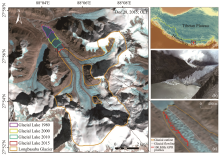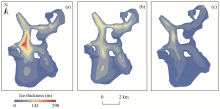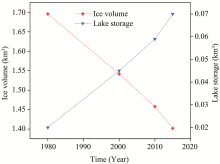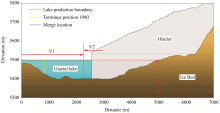Sciences in Cold and Arid Regions ›› 2020, Vol. 12 ›› Issue (6): 477–490.doi: 10.3724/SP.J.1226.2020.00477
Thickness estimation of the Longbasaba Glacier: methods and application
GuangLi He1,JunFeng Wei1( ),Xin Wang1,2
),Xin Wang1,2
- 1.School of Resource Environment and Safety Engineering, Hunan University of Science and Technology, Xiangtan, Hunan 411100, China
2.State Key Laboratory of Cryospheric Science, Northwest Institute of Ecology and Environmental Resources, Chinese Academy of Sciences, Lanzhou, Gansu 730000, China
|
Bahr DB, Meier MF, Peckham SD, 1997. The physical basis of glacier volume‐area scaling. Journal of Geophysical Research: Solid Earth, 102(B9): 20355-20362. DOI: 10.1029/97jb01696.
doi: 10.1029/97jb01696 |
|
|
Bahr DB, Pfeffer WT, Kaser G, 2015. A review of volume-area scaling of glaciers. Reviews of Geophysics, 53(1): 95-140. DOI: 10.1002/2014rg000470.
doi: 10.1002/2014rg000470 |
|
|
Beamer JP, Hill DF, Mcgrath D, et al., 2017. Hydrologic impacts of changes in climate and glacier extent in the Gulf of Alaska watershed. Water Resources Research, 53(9): 7502-7520. DOI: 10.1002/2016wr020033.
doi: 10.1002/2016wr020033 |
|
|
Bolch T, Menounos B, Wheate R, 2010. Landsat-based inventory of glaciers in western Canada, 1985-2005. Remote Sensing of Environment, 114(1): 127-137. DOI: 10.1016j.rse.2009.08.015.
doi: 10.1016j.rse.2009.08.015 |
|
|
Brinkerhoff DJ, Aschwanden A, Truffer M, 2016. Bayesian inference of subglacial topography using mass conservation. Frontiers in Earth Science, 4(8): 1-15. DOI: 10.3389/feart. 2016.00008.
doi: 10.3389/feart. 2016.00008 |
|
| Budd WF, Allison IF, 1975. An empirical scheme for estimating the dynamics of unmeasured glaciers. Proceedings of the Moscow Symposium "Snow and Ice", pp. 246-256. | |
| Chen J, Ohmura A, 1990. Estimation of Alpine glacier water resources and their change since the 1870s. Hydrology in Mountainous Regions I - Uydrological Measurements; the Water Cycle. Proceedings of two Lausanne Symposia, August, 1990. IAHS Publication, 193: 127-135. | |
|
Clarke GK, Berthier E, Schoof CG, et al., 2009. Neural networks applied to estimating subglacial topography and glacier volume. Journal of Climate, 22(8): 2146-2160. DOI: 10.1175/2008JCLI2572.1.
doi: 10.1175/2008JCLI2572.1 |
|
|
Clarke GK, Anslow FS, Jarosch AH, et al., 2013. Ice volume and subglacial topography for western Canadian glaciers from mass balance fields, thinning rates, and a bed stress model. Journal of Climate, 26(12): 4282-4303. DOI: 10. 1175/JCLI-D-12-00513.1.
doi: 10. 1175/JCLI-D-12-00513.1 |
|
|
Das PK, 2015. Global warming, glacial lakes and cloud burst events in Garhwal-Kumaon Himalaya: a hypothetical analysis. International Journal of Environmental Sciences, 5(4): 697-708. DOI: 10.6088/ijes.2014050100065.
doi: 10.6088/ijes.2014050100065 |
|
|
Farinotti D, Huss M, Bauder A, et al., 2009a. An estimate of the glacier ice volume in the Swiss Alps. Global and Planetary Change, 68(3): 225-231. DOI: 10.1016/j.gloplacha. 2009.05.004.
doi: 10.1016/j.gloplacha. 2009.05.004 |
|
|
Farinotti D, Huss M, Bauder A, et al., 2009b. A method to estimate the ice volume and ice-thickness distribution of alpine glaciers. Journal of Glaciology, 55(191): 422-430. DOI: 10.3189/002214309788816759.
doi: 10.3189/002214309788816759 |
|
|
Farinotti D, Corr H, Gudmundsson GH, 2013. The ice thickness distribution of Flask Glacier, Antarctic Peninsula, determined by combining radio-echo soundings, surface velocity data and flow modelling. Annals of Glaciology, 54(63): 18-24. DOI: 10.3189/2013aog63a603.
doi: 10.3189/2013aog63a603 |
|
|
Farinotti D, Brinkerhoff DJ, Clarke GKC, et al., 2017. How accurate are estimates of glacier ice thickness? Results from ITMIX, the Ice Thickness Models Intercomparison eXperiment. The Cryosphere, 11(2): 949-970. DOI: 10.5194/tc-11-949-2017.
doi: 10.5194/tc-11-949-2017 |
|
|
Farinotti D, Huss M, Fürst JJ, et al., 2019. A consensus estimate for the ice thickness distribution of all glaciers on Earth. Nature Geoscience, 12(3): 168-173. DOI: 10.1038/ s41561-019-0300-3.
doi: 10.1038/ s41561-019-0300-3 |
|
|
Fastook JL, Brecher HH, Hughes TJ, 1995. Derived bedrock elevations, strain rates and stresses from measured surface elevations and velocities: Jakobshavns Isbræ, Greenland. Journal of Glaciology, 41(137): 161-173. DOI: 10.3189/s0022143000017858.
doi: 10.3189/s0022143000017858 |
|
|
Frey H, Machguth H, Huss M, et al., 2014. Estimating the volume of glaciers in the Himalayan-Karakoram region using different methods. The Cryosphere, 8(6): 2313-2333. DOI: 10.5194/tc-8-2313-2014.
doi: 10.5194/tc-8-2313-2014 |
|
|
Gantayat P, Kulkarni AV, Srinivasan J, 2014. Estimation of ice thickness using surface velocities and slope: case study at Gangotri Glacier, India. Journal of Glaciology, 60(220): 277-282. DOI: 10.3189/2014jog13j078.
doi: 10.3189/2014jog13j078 |
|
| Glen JW, 1955. The creep of polycrystalline ice. Proceedings of the Royal Society of London. Series A. Mathematical and Physical Sciences, 228(1175): 519-538. | |
|
Grinsted A, 2013. An estimate of global glacier volume. The Cryosphere, 7(1): 141. DOI: 10.5194/tc-7-141-2013.
doi: 10.5194/tc-7-141-2013 |
|
|
Gudmundsson GH, 1999. A three-dimensional numerical model of the confluence area of Unteraargletscher, Bernese Alps, Switzerland. Journal of Glaciology, 45(150): 219-230. DOI: 10.3189/s0022143000001726.
doi: 10.3189/s0022143000001726 |
|
| Gudmundsson GH, Thorsteinsson T, Raymond C, 2001. Inferring bed topography and stickiness from surface data on ice streams. AGU Fall Meeting Abstracts. | |
|
Guo WQ, Liu SY, Wei JF, et al., 2013. The 2008/09 surge of central Yulinchuan glacier, northern Tibetan Plateau, as monitored by remote sensing. Annals of Glaciology, 54(63): 299-310. DOI: 10.3189/2013aog63a495.
doi: 10.3189/2013aog63a495 |
|
|
Guo WQ, Liu SY, Xu JL, et al., 2015. The second Chinese glacier inventory: data, methods and results. Journal of Glaciology, 61(226): 357-372. DOI: 10.3189/2015jog14j209.
doi: 10.3189/2015jog14j209 |
|
|
Haeberli W, Hölzle M, 1995. Application of inventory data for estimating characteristics of and regional climate-change effects on mountain glaciers: a pilot study with the European Alps. Annals of Glaciology, 21: 206-212. DOI: 10.1017/s0260305500015834.
doi: 10.1017/s0260305500015834 |
|
| Haeberli W, Zemp M, Kääb A, et al., 2008. Fluctuations of glaciers 2000-2005. Fluctuations of Glaciers, 9: 1-266. | |
|
Haq MA, Jain K, Menon K, 2014. Modelling of Gangotri glacier thickness and volume using an artificial neural network. International Journal of Remote Sensing, 35(16): 6035-6042. DOI: 10.1080/01431161.2014.943322.
doi: 10.1080/01431161.2014.943322 |
|
|
Hubbard A, Blatter H, Nienow P, et al., 1998. Comparison of a three-dimensional model for glacier flow with field data from Haut Glacier d'Arolla, Switzerland. Journal of Glaciology, 44(147): 368-378. DOI: 10.1017/s0022143000002690.
doi: 10.1017/s0022143000002690 |
|
|
Huggel C, Kääb A, Haeberli W, et al., 2003. Regional-scale GIS-models for assessment of hazards from glacier lake outbursts: evaluation and application in the Swiss Alps. Natural Hazards and Earth System Sciences, 3: 647-662. DOI: 10.5194/nhess-3-647-2003.
doi: 10.5194/nhess-3-647-2003 |
|
|
Huss M, Sugiyama S, Bauder A, et al., 2007. Retreat scenarios of Unteraargletscher, Switzerland, using a combined ice-flow mass-balance model. Arctic, Antarctic, and Alpine Research, 39(3): 422-431. DOI: 10.1657/1523-0430(06-036)hussl2.0.co;2.
doi: 10.1657/1523-0430(06-036)hussl2.0.co;2 |
|
|
Huss M, Farinotti D, 2012. Distributed ice thickness and volume of all glaciers around the globe. Journal of Geophysical Research: Earth Surface, 117: F04010. DOI: 10.1029/2012jf002523.
doi: 10.1029/2012jf002523 |
|
|
Huss M, Farinotti D, 2014. A high-resolution bedrock map for the Antarctic Peninsula. The Cryosphere, 8(4): 1261-1273. DOI: 10.5194/tc-8-1261-2014.
doi: 10.5194/tc-8-1261-2014 |
|
|
Immerzeel WW, Van Beek LPH, Bierkens MFP, 2010. Climate change will affect the Asian water towers. Science, 328(5984): 1382-1385. DOI: 10.1126/science.1183188.
doi: 10.1126/science.1183188 |
|
|
Immerzeel WW, Bierkens MFP, 2012. Asia's water balance. Nature Geoscience, 5(12): 841-842. DOI: 10.1038/ngeo1643.
doi: 10.1038/ngeo1643 |
|
|
James WH, Carrivick JL, 2016. Automated modelling of spatially-distributed glacier ice thickness and volume. Computers & Geosciences, 92: 90-103. DOI: 10.1016/j.cageo. 2016.04.007.
doi: 10.1016/j.cageo. 2016.04.007 |
|
| Khasanov K, 2020. Evaluation of ASTER DEM and SRTM DEM data for determining the area and volume of the water reservoir. IOP Conference Series: Materials Science and Engineering, pp. 012063. | |
|
Langhammer L, Grab M, Bauder A, et al., 2019. Glacier thickness estimations of alpine glaciers using data and modeling constraints. Cryosphere, 13(8): 2189-2202. DOI: 10.5194/tc-13-2189-2019.
doi: 10.5194/tc-13-2189-2019 |
|
|
Lemke P, Ren J, Alley RB, et al., 2007. Observations: Changes in Snow, Ice and Frozen Ground. Cambridge, United Kingdom and New York, NY, USA: Cambridge University Press, pp. 339-383. DOI: US20070163584 A1.
doi: US20070163584 A1 |
|
|
Li HL, Ng F, Li ZQ, et al., 2012. An extended "perfect—plasticity" method for estimating ice thickness along the flow line of mountain glaciers. Journal of Geophysical Research: Earth Surface, 117(F01020): 1-11. DOI: 10.1029/2011jf002104.
doi: 10.1029/2011jf002104 |
|
|
Linsbauer A, Paul F, Haeberli W, 2012. Modeling glacier thickness distribution and bed topography over entire mountain ranges with GlabTop: Application of a fast and robust approach. Journal of Geophysical Research: Earth Surface, 117: F03007. DOI: 10.1029/2011jf002313.
doi: 10.1029/2011jf002313 |
|
|
Liu Q, Mayer C, Wang X, et al., 2020. Interannual flow dynamics driven by frontal retreat of a lake-terminating glacier in the Chinese Central Himalaya. Earth and Planetary Science Letters, 546: 116450. DOI: 10.1016/j.epsl.2020.116450.
doi: 10.1016/j.epsl.2020.116450 |
|
|
Lüthi MP, 2009. Transient response of idealized glaciers to climate variations. Journal of Glaciology, 55(193): 918-930. DOI: 10.3189/002214309790152519.
doi: 10.3189/002214309790152519 |
|
|
Mayer C, Schaffer J, Hattermann T, et al., 2018. Large ice loss variability at Nioghalvfjerdsfjorden Glacier, Northeast-Greenland. Nature Communications, 9(1): 1-11. DOI: 10. 1038/s41467-018-05180-x.
doi: 10. 1038/s41467-018-05180-x |
|
|
McNabb R, Hock R, O'Neel S, et al., 2012. Using surface velocities to calculate ice thickness and bed topography: a case study at Columbia Glacier, Alaska, USA. Journal of Glaciology, 58(212): 1151-1164. DOI: 10.3189/2012jog11j249.
doi: 10.3189/2012jog11j249 |
|
|
Michel L, Picasso M, Farinotti D, et al., 2013. Estimating the ice thickness of mountain glaciers with an inverse approach using surface topography and mass-balance. Inverse Problems, 29(3): 035002. DOI: 10.1088/0266-5611/29/3/035002.
doi: 10.1088/0266-5611/29/3/035002 |
|
|
Michel L, Picasso M, Farinotti D, et al., 2014. Estimating the ice thickness of shallow glaciers from surface topography and mass-balance data with a shape optimization algorithm. Computers & Geosciences, 66: 182-199. DOI: 10. 1016/j.cageo.2014.01.012.
doi: 10. 1016/j.cageo.2014.01.012 |
|
|
Morlighem M, Rignot E, Seroussi H, et al., 2011. A mass conservation approach for mapping glacier ice thickness. Geophysical Research Letters, 38: L19503. DOI: 10.1029/2011gl048659.
doi: 10.1029/2011gl048659 |
|
|
Mosbeux C, Gillet-Chaulet F, Gagliardini O, 2016. Comparison of adjoint and nudging methods to initialise ice sheet model basal conditions. Geoscientific Model Development, 9(7): 2549-2562. DOI: 10.5194/gmd-9-2549-2016.
doi: 10.5194/gmd-9-2549-2016 |
|
|
Nye JF, 1952. The mechanics of glacier flow. Journal of Glaciology, 2(12): 82-93. DOI: 10.1017/s0022143000033967.
doi: 10.1017/s0022143000033967 |
|
|
Pandit A, Ramsankaran R, 2020. Modeling ice thickness distribution and storage volume of glaciers in Chandra Basin, western Himalayas. Journal of Mountain Science, 17(8): 2011-2022. DOI: 10.1007/s11629-019-5718-y.
doi: 10.1007/s11629-019-5718-y |
|
|
Parry ML, Canziani OF, Palutikof JP, et al., 2007. IPCC, 2007: Climate Change 2007: Impacts, Adaptation and Vulnerability. Contribution of Working Group II to The Fourth Assessment Report of The Intergovernmental Panel on Climate Change. Cambridge University Press, Cambridge, UK. DOI: 10.2134/jeq2008.0015br.
doi: 10.2134/jeq2008.0015br |
|
| Paterson WSB, Cuffey K, 1994. The Physics of Glaciers. New York: Pergamon Press. | |
|
Pieczonka T, Bolch T, Kröhnert M, et al., 2018. Glacier branch lines and glacier ice thickness estimation for debris-covered glaciers in the Central Tien Shan. Journal of Glaciology, 64(247): 835-849. DOI: 10.1017/jog.2018.75.
doi: 10.1017/jog.2018.75 |
|
| Portner HO, Roberts DC, Masson-Delmotte V, et al., 2019. IPCC, 2019: IPCC Special Report on the Ocean and Cryosphere in a Changing Climate. November 8, 2019. , 2020 | |
|
Pralong MR, Gudmundsson GH, 2011. Bayesian estimation of basal conditions on Rutford Ice Stream, West Antarctica, from surface data. Journal of Glaciology, 57(202): 315-324. DOI: 10.3189/002214311796406004.
doi: 10.3189/002214311796406004 |
|
|
Pritchard HD, King EC, Goodger DJ, et al., 2020. Towards Bedmap Himalayas: development of an airborne ice-sounding radar for glacier thickness surveys in High-Mountain Asia. Annals of Glaciology, 61(81): 35-45. DOI: 10.1017/aog.2020.29.
doi: 10.1017/aog.2020.29 |
|
|
Rabatel A, Sanchez O, Vincent C, et al., 2018. Estimation of glacier thickness from surface mass balance and ice flow velocities: a case study on Argentière Glacier, France. Frontiers in Earth Science, 6(112): 1-16. DOI: 10.3389/feart. 2018.00112.
doi: 10.3389/feart. 2018.00112 |
|
|
Radić V, Hock R, 2011. Regionally differentiated contribution of mountain glaciers and ice caps to future sea-level rise. Nature Geoscience, 4(2): 91-94. DOI: 10.1038/ngeo1052.
doi: 10.1038/ngeo1052 |
|
|
Rasmussen LA, 1988. Bed topography and mass-balance distribution of Columbia Glacier, Alaska, USA, determined from sequential aerial photography. Journal of Glaciology, 34(117): 208-216. DOI: 10.1017/s0022143000032251.
doi: 10.1017/s0022143000032251 |
|
| Rastner P, Paul F, 2020. Which DEM to use for glacier inventory applications? The example of Svalbard. EGU General Assembly2020, pp. 11059. | |
|
Ren JW, Qin DH, Kang SC, et al., 2004. Glacier variations and climate warming and drying in the central Himalayas. Chinese Science Bulletin, 49(1): 65-69. DOI: 10.1007/bf02901744.
doi: 10.1007/bf02901744 |
|
|
Rutishauser A, Maurer H, Bauder A, 2016. Helicopter-borne ground-penetrating radar investigations on temperate alpine glaciers: A comparison of different systems and their abilities for bedrock mapping. Helicopter GPR on temperate glaciers. Geophysics, 81(1): 119-129. DOI: 10.1190/geo2015-0144.1.
doi: 10.1190/geo2015-0144.1 |
|
|
Shangguan DH, Liu SY, Ding YJ, et al., 2010. Changes in the elevation and extent of two glaciers along the Yanglonghe river, Qilian Shan, China. Journal of Glaciology, 56(196): 309-317. DOI: 10.3189/002214310791968566.
doi: 10.3189/002214310791968566 |
|
| Sun B, Zhang P, Jiao KQ, et al., 2003. Determination of ice thickness, subice topography and ice volume at Glacier No. 1 in Tien Shan, China by ground penetrating radar. Advances in Polar Science, 14(2): 90-98. (in Chinese) | |
|
Thorsteinsson T, Raymond CF, Gudmundsson GH, et al., 2003. Bed topography and lubrication inferred from surface measurements on fast-flowing ice streams. Journal of Glaciology, 49(167): 481-490. DOI: 10.3189/172756503781830502.
doi: 10.3189/172756503781830502 |
|
|
Van Pelt W, Oerlemans J, Reijmer C, et al., 2013. An iterative inverse method to estimate basal topography and initialize ice flow models. The Cryosphere, 7(3): 987-1006. DOI: 10.5194/tc-7-987-2013.
doi: 10.5194/tc-7-987-2013 |
|
|
Van Tiel M, Kohn I, Van Loon AF, et al., 2020. The compensating effect of glaciers: Characterizing the relation between interannual streamflow variability and glacier cover. Hydrological Processes, 34(3): 553-568. DOI: 10.1002/hyp.13603.
doi: 10.1002/hyp.13603 |
|
|
Wang X, Liu SY, Guo WQ, et al., 2008. Assessment and simulation of glacier lake outburst floods for Longbasaba and Pida Lakes, China. Mountain Research and Development, 28(3): 310-317. DOI: 10.1659/mrd.0894.
doi: 10.1659/mrd.0894 |
|
|
Wang X, Ding YJ, Liu SY, et al., 2013. Changes of glacial lakes and implications in Tian Shan, central Asia, based on remote sensing data from 1990 to 2010. Environmental Research Letters, 8(4): 044052. DOI: 10.1088/1748-9326/8/4/044052.
doi: 10.1088/1748-9326/8/4/044052 |
|
|
Wang X, Yang CD, Zhang YL, et al., 2018. Monitoring and simulation of hydrothermal conditions indicating the deteriorating stability of a perennially frozen moraine dam in the Himalayas. Journal of Glaciology, 64(245): 407-416. DOI: 10.1017/jog.2018.38.
doi: 10.1017/jog.2018.38 |
|
|
Wei JF, Liu SY, Xu JL, et al., 2015. Mass loss from glaciers in the Chinese Altai Mountains between 1959 and 2008 revealed based on historical maps, SRTM, and ASTER images. Journal of Mountain Science, 12(2): 330-343. DOI: 10.1007/s11629-014-3175-1.
doi: 10.1007/s11629-014-3175-1 |
|
|
Welty E, Zemp M, Navarro F, et al., 2020. Worldwide version-controlled database of glacier thickness observations. Earth System Science Data Discussions, 1-27. DOI: 10.5194/essd-2020-87.
doi: 10.5194/essd-2020-87 |
|
|
Wu KP, Liu SY, Jiang ZL, et al., 2018. Recent glacier mass balance and area changes in the Kangri Karpo Mountains from DEMs and glacier inventories. The Cryosphere, 12(1): 103-121. DOI: 10.5194/tc-12-103-2018.
doi: 10.5194/tc-12-103-2018 |
|
|
Wu KP, Liu SY, Zhu Y, et al., 2020. Dynamics of glacier surface velocity and ice thickness for maritime glaciers in the southeastern Tibetan Plateau. Journal of Hydrology, 125527: 1-9. DOI: 10.1016/j.jhydrol.2020.125527.
doi: 10.1016/j.jhydrol.2020.125527 |
|
|
Yang XC, Zhang YL, Zhang W, et al., 2006. Climate change in Mt. Qomolangma region in China during the last 34 years. Acta Geographica Sinica-Chinese, 61(7): 687-696. DOI: 10.1016/S1003-6326(06)60040-X.
doi: 10.1016/S1003-6326(06)60040-X |
|
|
Yao XJ, Liu SY, Wei JF, 2010. Reservoir capacity calculation and variation of moraine-dammed lakes in the north Himalayas: A case study of Longbasaba Lake. Acta Geographica Sinica, 65: 1381-1390. DOI: 10.3189/2012JoG11J048. (in Chinese)
doi: 10.3189/2012JoG11J048. |
|
|
Yao XJ, Liu SY, Sun MP, et al., 2012. Volume calculation and analysis of the changes in moraine-dammed lakes in the north Himalaya: a case study of Longbasaba lake. Journal of Glaciology, 58(210): 753-760. DOI: 10.3189/2012jog11j048.
doi: 10.3189/2012jog11j048 |
|
|
Yao XJ, Liu SY, Zhu Y, et al., 2015. Design and implementation of an automatic method for deriving glacier centerlines based on GIS. Journal of Glaciology & Geocryology, 37(6): 1563-1570. DOI: 10.7522/j.issn.1000-0240.2015. 0173. (in Chinese)
doi: 10.7522/j.issn.1000-0240.2015. 0173. |
|
| Zamora R, Uribe J, Oberreuter J, et al., 2017. Ice thickness surveys of the Southern Patagonian Ice Field using a low frequency ice penetrating radar system. 2017 First IEEE International Symposium of Geoscience and Remote Sensing (GRSS-CHILE). IEEE, pp. 1-4. | |
|
Zhang JT, He XJ, Shangguan DH, et al., 2012. Impact of intensive glacier ablation on arid regions of northwest China and its countermeasure. Journal of Glaciology and Geocryology, 34(4): 848-854. DOI: 10.1007/s11783-011-0280-z.
doi: 10.1007/s11783-011-0280-z |
|
|
Zhang Z, Liu SY, Wei JF, et al., 2016. Mass change of glaciers in Muztag Ata-Kongur Tagh, Eastern Pamir, China from 1971/76 to 2013/14 as derived from remote sensing data. PloS One, 11(1): e0147327. DOI: 10.1371/journal.pone. 0147327.
doi: 10.1371/journal.pone. 0147327 |
|
|
Zhao XR, Wang X, Wei JF, et al., 2020. Spatiotemporal variability of glacier changes and their controlling factors in the Kanchenjunga region, Himalaya, based on multi-source remote sensing data from 1975 to 2015. Science of the Total Environment, 745: 140995. DOI: 10.1016/j.scitotenv. 2020.140995.
doi: 10.1016/j.scitotenv. 2020.140995 |
| No related articles found! |












